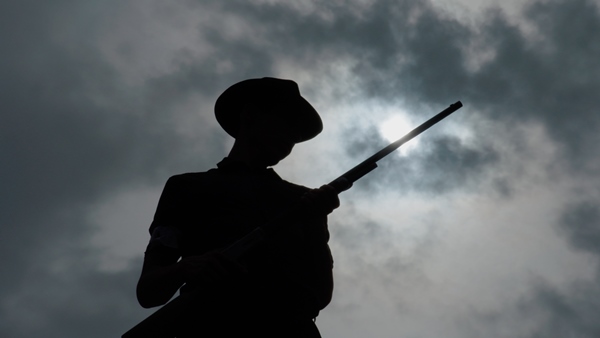![]() Why would a town stage a mass reenactment of a terrible event that occurred 100 years earlier? Director Robert Greene (Kate Plays Christine) explores that question with one of the best films so far this year: a powerful meditation on art’s transformative abilities, as well as a sobering reminder that in any conflict, it’s the victors who usually write the official history.
Why would a town stage a mass reenactment of a terrible event that occurred 100 years earlier? Director Robert Greene (Kate Plays Christine) explores that question with one of the best films so far this year: a powerful meditation on art’s transformative abilities, as well as a sobering reminder that in any conflict, it’s the victors who usually write the official history.
Circa 1917, the border town of Bisbee, Arizona, was the site of the Copper Queen Mine, a vital source of the metal used to create bullets for American soldiers fighting overseas. Yet while the mine owners were making money hand over first, they exploited their largely immigrant workforce. Union agitators infiltrated the miners’ camp, convincing them to go on strike for better conditions, which led to both management and the miner’s own neighbors responding viciously. As we are informed by an opening crawl, about 2,000 deputized residents gathered the striking workers at gunpoint, put them in cattle cars, and then drove them out to the New Mexico desert, abandoning them to die.
The film then segues to present-day Bisbee, which has fallen far from its glory days; the last copper mine has been shut down for decades. Greene interviews a number of residents, many of whom have familial connections to what has become known as the Bisbee Deportation. Some are descended from those who did the deporting and have a positive view of it, but there are others who moved to the town more recently, and they are the ones who want to reenact it—to expose it as an act of ethnic cleansing. The evidence can be found in public records: the vast majority of those deported came from outside the United States, while the majority of those deputized have Anglo-Saxon names.
In an approach similar to Kate Plays Christine, Greene once again lets reality and art gradually blur together. Many of the reenactors have politics that are very similar to the persons they have chosen to play, and it’s fascinating to see everyone get into character, as for some it’s a considerable process. While for others, where the role begins and the actor ends become less clear over time. One of the most compelling participants is a youth named Fernando, who plays a Mexican miner who initially hesitates to get involved with the strike. Fernando admits to not being very political in real life. A longtime resident of Bisbee, he also struggles to reconcile the racism of its past with the welcoming place he loves.
At times, the director utilizes long takes that invite us to observe the actors when they are not in character, which highlights just how dramatic their transformations are. One of the biggest surprises involves the actress who plays Fernando’s mother, who appears in-character at first, but then she drops the mannerisms, and in a lengthy conversation, she reveals herself to be the exact opposite of who she plays.
Despite lots of talking heads, the film at times utilizes highly evocative visuals. Early on, Greene stages a montage featuring a longtime resident who recorded a radio series on the town’s history, which omitted the deportation. She silently travels from place to place, listening to the broadcast through headphones until someone calls in to complain about the oversight, at which point she takes off the headphones and walks off—an act representative of what nearly the entire town has done for a century. The tone is also dryly humorous on occasion. In the nearby tourist town of Tombstone, the staged gunfights appear quaint compared to the arguably more insidious Bisbee Deportation.
Though the film provides equal time to both sides, it frames those who choose to play the pro-company figures in a somewhat suspicious light, with eerie electronic music that may be intended to make a viewer question what their true motivations are. There is also the curious choice to give each side a brief musical number, which for the workers is rousing, while the company men and loyalists—who pledge loyalty to the Copper Queen Mine above all—come across as pompous and more than a bit ridiculous. It’s as if the filmmakers were opting to take them down a peg ahead of their real-life victory.
The second half consists of a slow burn right up until the dramatization of the deportation, in which prior efforts to get viewers emotionally involved in the various characters and their struggles pay off. The forced exiling, which seems to unfold in real time, is chaotic and appropriately harrowing, a remarkable feat given the constant reminders that everything is staged. Indeed, actors who are shot dead reawaken a short time later, and there are cuts to non-participants on the sidelines—mostly those who had previously expressed support for the deportation—to see if perhaps they have changed their minds.
Bisbee ’17 ends on a bittersweet note as the participants succeed in humanizing those victimized by the original event. At the same time, the reenactment gives an idea of the full scale of the tragedy. Nevertheless, as one participant points out, the only way to keep incidents like this from happening again is to properly process them, and given that racial tensions in the United States are not going anywhere—especially in border towns such as Bisbee—there is something undeniably important about what has been accomplished here.







Leave A Comment